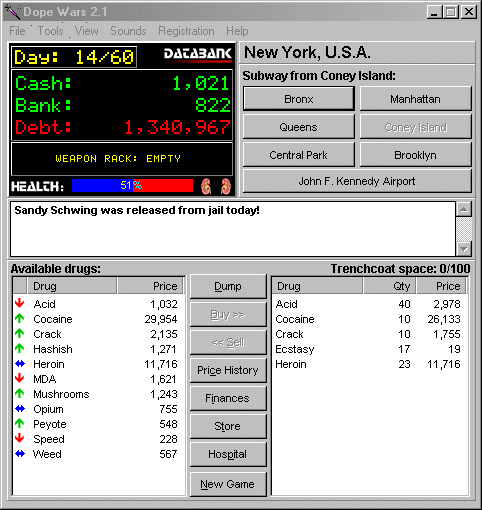College Admissions
College Admissions
Preparing for College
The Best College for You
What to Study
Applications
Education Options
Education Options
Private Universities
Public & State Universities
Community Colleges
Scholarships
Scholarships
African American Scholarships
Latino Scholarships
Native American Scholarships
Women Scholarships
College Grants
College Grants
Federal Grants
Merit Based Grants
Need Based Grants
Student Loans
Student Loans
Federal Student Loans
State Student Loans
No Co-signer Student Loans
Bad Credit Loans
Student Loan Consolidation
College Survival
College Survival
Financial Aid Tips
The Digital Student Blog
How many times have you tried, unsuccessfully, to explain your feelings to adults?
That you love the competition and the socialization that video games provide. That you simply enjoy trying to figure the game out.
As for the violent games, well, they add that one additional level, providing action and a rush of adrenalin that mirrors what you feel when competing on a field or in the gym.
 Most importantly, they help you cope with anger and stress. After a particularly difficult day or week, there is nothing like immersing oneself in a violent video game. I mean, where else can you take out your anger in such an innocent way?
Most importantly, they help you cope with anger and stress. After a particularly difficult day or week, there is nothing like immersing oneself in a violent video game. I mean, where else can you take out your anger in such an innocent way?
That explanation is particularly difficult with mom who can understand the competition and thus is willing to accept games like Pac Man or Madden football. But for the life of her, she simply cannot understand your enjoyment with a game like Grand Theft Auto?
Support for Violent Video Games
Well, for those who have tried to somehow explain, you can now point the skeptics to yet another study that indicates that concerns with violent video games is over blown. That in fact, researchers presenting at the New York University ‘Games for Learning’ symposium, have reached the conclusion that even violent video games can be utilized as learning tools.
Consider first that Sigmund Tobias of the State University of New York at Albany noted that an “Israeli air force study found that students who played the game Space Fortress had better rankings in their pilot training than students who did not.”
Even better, consider what Daphne Bavelier, an assistant professor in the department of brain and cognitive science at the University of Rochester who has focused her research on games like Unreal Tournament and Medal of Honor, had to say about fast-paced shooter games:
 “People that play these fast-paced games have better vision, better attention, and better cognition,” she stated. She went on to suggest that such games could well improve math performance and other brain tasks as well.
“People that play these fast-paced games have better vision, better attention, and better cognition,” she stated. She went on to suggest that such games could well improve math performance and other brain tasks as well.
“We are testing this hypothesis that when you play an action video game, what you do is you learn to better allocate your resources,” she offered. “In a sense you learn to learn. … You become very good at adapting to whatever is asked of you.”
Just Having Fun
Of course, none of these has any ultimate implication for why it is that you play. As we said, for most of us, it is all about the competition, the challenge, and the chance to put day to day struggles aside for a period of time.
You couldn’t care less as to whether your peripheral vision has been enhanced or that these games test your ability to detect small activities on the screen. In reality, for you it is nothing more than simply having fun.
But it is nice to see that some folks have begun to question the typical reaction, that because many adults cannot understand the attraction of such games, they immediately insist that the games cannot be good for us. More to the point it is nice to see that a professor like Bavelier could actually suggest that first-person shooter games “eventually will become part of school curricula” even if “it’s going to take a generation” to accept such findings.
Unrealistic to Expect Understanding
OK, it is probably wishful thinking on our part that you might be able to completely change your parents mind. Pointing them in the direction of other studies could even work against you in the long run.
But at least it is reinforcing to read that college professors actually are beginning to understand that you and your buddies love for a little video warfare is not a sign of sickness, that you can enjoy the video games that feature violence without becoming a menace to society.
Medal of Honor anyone?
Once upon a time, it was lumped together with the harshest of drugs. But in recent years marijuana has started claiming a new place in society.
As states continue to enact medical marijuana usage legislation, those responsible for implementing the new laws have been charged with designing growth and distribution requirements and protocols. The result is an emerging industry that some think could one day rival a significant sector of the pharmaceutical industry.
As a student, dare we even say it, you may be interested in knowing there is a college that features training in this emerging field.
Oaksterdam University
Founded in November 2007 by Richard Lee, Oaksterdam University sounds like a high school dropout’s dream. The school began with an “extremely provocative advertisement in the East Bay Express proclaiming ‘Cannabis Industry Now Hiring’.”
 Inspired by his visit to the cannabis college in Amsterdam, Lee envisioned a school that offered a different program than the horticulture focus of the college in Amsterdam.
Inspired by his visit to the cannabis college in Amsterdam, Lee envisioned a school that offered a different program than the horticulture focus of the college in Amsterdam.
While offering a program that still does fundamental study in horticulture, Lee expanded on the cannabis college idea to create a trade school. His idea was to try to legitimize the cannabis industry, particularly as it relates to the field of medical marijuana.
According to the school’s web site, “20 lucky and trailblazing students packed into a small classroom in Oaksterdam located on 15th Street” in what was to be the first official course offering. That class reportedly was taught by some of the biggest names in the cannabis industry: Chris Conrad, Richard Lee, Lawrence Lichter, and Dennis Peron.
Soon armed with a 3-month waiting list for class openings, the school began expanding. As class sizes grew, course offerings grew in frequency and in format.
In 2008, Lee opened a satellite school in Los Angeles. Later, when Michigan passed its medical cannabis law, Oaksterdam University brought its program to Ann Arbor and held the first Michigan class in May of 2009.
Shortly thereafter, the latest campus, North Bay in Sebastopol, California was opened. And in November of 2009 the main campus branch moved to a sprawling 30,000 sq.ft. campus at 1600 Broadway, in Oakland. The new campus is home to numerous classrooms, two auditoriums, a grow lab, and a theater.
Course Programs
Oaksterdam University offers two distinctive formats. For those with a casual interest, the school offers a number of weekend seminars at $250 per seminar.
For those with a desire to learn more about cannabis, the school also offers a comprehensive Semester Program called the Classic Semester. This format meets once a week for 13 weeks with two and a half hours of instruction per class (a total of roughly 32 hours of instruction) and costs $650.
In addition to expert instructors and the guest speakers, each week also includes a comprehensive grow lab experience. According to the Oaksterdam site, accomplished horticulturists walk students, week-by-week, through growing their first garden.
Those students choosing the Semester Course may earn a number of certificates. The school offers two fundamental certificates: a Certificate of Attendance for those who attend all classes and a Certificate of Completion for those who attend all classes, complete the midterm and pass the final.
In addition, for the more industrious, the school offers a Certificate of Completion with Honors. To receive such designation a student must also complete all weekly homework assignments and attend a field trip, in addition to the basic attendance and exam criteria. Lastly, a Certificate of Achievement with Honors is awarded to the Class Valedictorian, and in some cases, to those demonstrating “extraordinary levels of valor and volunteerism.”
 For those wondering more about the curriculum, the Classic Semester offers an eclectic mix of topics including two Horticulture offerings: Horticulture and Horticulture: Advanced Grow. It also offers several legal units including: Federal Vs State Law; Legal Rights; and a Know Your Rights workshop.
For those wondering more about the curriculum, the Classic Semester offers an eclectic mix of topics including two Horticulture offerings: Horticulture and Horticulture: Advanced Grow. It also offers several legal units including: Federal Vs State Law; Legal Rights; and a Know Your Rights workshop.
As for an understanding of the medical marijuana industry, other units offered include Politics & History; Patient Relations (formerly Budtending); Dispensary Operations (formerly Dispensary Management); and Procurement & Allocation (formerly Distribution),
In addition, time is spent on three Methods of Ingestion offerings: Extracts; Cooking (includes a step-by-step tutorial on how to make cannabutter); and Vaporizing. There is also a science offering called The Science of Cannabis (formerly Medical Cannabis) as well as two business based offerings: Economic$ and Cannabusiness: Legal Business Structures.
The goal of the program is simple – to help a student either prepare for
employment in a dispensary or to start a business of their own.
Interested Students
Students interested in enrolling will be pleased to learn that admission is essentially first paid, first served. No one is interested in your GPA, or your SAT scores. There is no need to have a wealth of extracurricular activities on your resume – the school doesn’t even ask for a resume.
But if you think it is all a walk in the park you may want to think again. If you are worried that your well-to-do uncle may disown you for selecting this career path you need to understand that your real, personal information must be included on your enrollment form. A failure to provide accurate information (no fictitious names like Token White) could result in your being denied a seat in the class.
And unfortunately, there are no scholarships available. Oaksterdam University indicates it needs your tuition to cover expenses. The school currently does not offer any online courses.
 And there is also that matter of a test, albeit optional, for those students who want certification from Oaksterdam University. To pass, students need a score of 75% or better.
And there is also that matter of a test, albeit optional, for those students who want certification from Oaksterdam University. To pass, students need a score of 75% or better.
Lastly, there are required textbooks: Marijuana Horticulture: The Indoor/Outdoor Medical Grower’s Bible, by Jorge Cervantes ($29.95 + tax), and Buds For Less, by SeeMoreBuds ($18.95 + tax). There is also a required DVD purchase: Busted! Flex Your Rights ($16.00 + tax).
Worse yet, there is even recommended supplemental texts if you are serious about the subject. They are not required mind you, just suggestions to expand your education. They include the Marijuana Medical Handbook, the Big Book of Buds Version 3, the Marijuana Garden Saver, Ask Ed, Marijuana Gold: Trash to Stash, Marijuana Cooking: Good Medicine Made Easy, and Organic Marijuana, Soma Style: The Pleasures of Cultivating Connoisseur Cannabis.
Most importantly, those who take their out of school studies/experiments/time too seriously need to understand that class attendance is expected. Refunds are not available for missed classes unless 7 days prior notice is provided (apparently planned parties may work).
A Leg Up?
And when it comes to promises, the school makes no pretenses about the certification that students can earn. When it comes to applying for a job at a dispensary, the school “hopes” that the certification program will give a student an advantage in the selection process over someone who is not certified.
Regular readers of “The Digital Student Blog” know first hand our fondness for technology. That is why we were so smitten with Charles Guan’s LOLrioKart, the electric powered shopping cart that has been seen tooling over the asphalt in Cambridge.
After learning about the cart at Gizmodo, we had to call our readers’ attention to Guan’s whimsical attempt to strap a set of large nickel cadmium batteries and a massive brushless motor to a derelict shopping cart. But our own fascination with technology and moving vehicles had us yearning for more – we simply had to hear firsthand from the creator himself.
 So we spent some time with Charles, he of the web site Equals Zero with URL etotheipiplusone.net (yes, that’s Euler’s Identity buried in his call letters), discussing his recent fame, the MIT campus culture and his desire to construct something, anything when given such wonderful parts. We think you will enjoy some of the lessons Charles has learned from constructing the LOLrioKart including dealing with steering slop, his Fred Flinstone braking system and the initial construction of a vehicle featuring only two speeds, zero and fast.
So we spent some time with Charles, he of the web site Equals Zero with URL etotheipiplusone.net (yes, that’s Euler’s Identity buried in his call letters), discussing his recent fame, the MIT campus culture and his desire to construct something, anything when given such wonderful parts. We think you will enjoy some of the lessons Charles has learned from constructing the LOLrioKart including dealing with steering slop, his Fred Flinstone braking system and the initial construction of a vehicle featuring only two speeds, zero and fast.
The folks at Gizmodo gave you some great publicity but they also called you a nerd on their site (seeing a motorized shopping cart with a nerd inside tooling around on the street). Are you OK with that, I mean their site is read by somewhere near a gazillion readers?
Pop culture comes up with new ways to describe “someone smarter or craftier than you” every once in a while, but the classics seem to be ‘nerd’ and ‘geek’. Besides the occasional (and inevitable) grade school hijinks, I don’t recall ever really being victimized or shunned when referred to in that fashion. Part of getting over that is acknowledging the reality of the game – that what you do or who you are is not what the majority of people are used to. It’s useless to be sensitive about every descriptive term that comes your way, especially since they evolve so quickly, and people are multifaceted enough that anyone could come up with a word and pretend it’s derogatory or obscene. I mean, just take a look at the sheer number words that we have turned into sexual slang.
Speaking of which, just make sure you’re careful to not call someone a dork. In reality, you are indicating that they are a whale penis. Whales tend to be larger than you in every single way. I’ve been unwittingly complimented in this fashion many times.
Just so we know, what in your eyes is the difference between a geek and a nerd – does it have anything to do with the desire to strap technology to something that moves?
I have never really discerned between ‘geek’ and ‘nerd’. The running joke between my friends years ago was that a geek was someone skilled or passionate in a specific, tangible field of interest or hobby – computer geek, band geek, robot geek, etc. the list goes on. We sort of chose to designate “nerds” as being the underclass – those who are incredibly, almost frighteningly smart, but in a purely academic sense.
This definition is clearly not the universal one, some may argue it’s the exact reverse, but you know what? I don’t really care. Labeling me as one thing or another doesn’t really impact how I do things, and it shouldn’t affect you either.
Can you talk a bit about your first “attempt to strap a massive brushless motor to something?” I believe you called the electric vehicle: Snuffles the First?
 Back in the summer of 2007, I came back from a trip to China with what I considered at the time to be “exotic equipment” – that is, brushless motors, precision-made actuators, lithium batteries, etc. The stuff that R/C hobbyists used to drop big money on but is now incredibly affordable, except my version of “affordable” was an order of magnitude or two lower. Keep in mind that for years before this I’d been hacking together robots with cordless drill, remote control toy, appliance, and other random parts, so this was pretty damned exciting.
Back in the summer of 2007, I came back from a trip to China with what I considered at the time to be “exotic equipment” – that is, brushless motors, precision-made actuators, lithium batteries, etc. The stuff that R/C hobbyists used to drop big money on but is now incredibly affordable, except my version of “affordable” was an order of magnitude or two lower. Keep in mind that for years before this I’d been hacking together robots with cordless drill, remote control toy, appliance, and other random parts, so this was pretty damned exciting.
One of these “exotic” parts was a large model airplane electric motor. Better-made equivalents from the depths of Germany and Switzerland are used to fly electric models with wingspans of 20 or more feet. Absolutely enormous. I didn’t really have anything that large (or really anything) to fly, so I sort of mulled over it wondering what I should do.
I frequented an area flea market, naturally to search for prospective robot parts. One of the usual toy vendors that day had a small electric scooter – the Sharper Image ElectricX2, roughly Razor scooter sized. Needless to say, when I saw this thing, the proverbial light bulb probably went off with enough intensity to start fusing hydrogen. It was totally trashed, the batteries were gone (and the guy had no charger, manual, or other support equipment), so I got it for a few bucks.
The first thing I did when I got home was tear everything down for inspection. When I discovered that the airplane motor could swap into the stock scooter motor’s place with minimal modification, it was pretty much on.
I kept all the build reports for that scooter on my website if you want to browse through it.
How successful would you categorize that endeavor?
While the execution was shaky – literally, because I didn’t have access to machine tools like I do now, it was absolutely a success in how much it taught me about Electric Vehicle technology. Stuff like what batteries would work the best, what motor controllers, and places to mount components. Spec-ing out these things for an EV is a lot different than for a combat robot. It was what threw me into the world of EV and hybrid technology that I’m sort of pursuing now.
Since the scooter was actually wired up and finished a few days before I moved to Massachusetts, I brought it along with me to campus. It was hilarious, and a big hit with the other frosh. People never really expected an electric scooter to kick them off like that.
The other way it was a success was that it landed me my first (and still ongoing) on-campus job as an undergraduate research assistant for Smart Cities. They posted an opening for a team that will be designing and building a light electric vehicle, a (street-legal, Vespa-style) electric scooter. Vespa…Razor… close enough, right?
Part of what I enjoy about engineering is the degree to which you can engage yourself in learning a new skill. You HAVE to DO it. It’s not something that can be read out of a book and repeated. If you measure success by how much you have improved your condition, then Snuffles the First was one hell of an accomplishment in that it taught me things which I can’t get from just sitting in class.
From your site I gathered the Nickel Cadmium batteries powering the LOLrioKart are not your ordinary flashlight batteries. How powerful are these?
 The large-format NiCd cells I ended up using in LOLrioKart were donations to our club from the Solar Electric Vehicle Team years ago. They were pretty tired batteries. Each pack comprises 11 cells, for a nameplate voltage of 13.2 volts. Problem is that nickel batteries are prone to developing internal crystalline parasitic structures that cause quick self-discharge, so many of the cells were just plain dead. I used a procedure called “zapping” to revive them. It pretty much boils down to injecting a massive high voltage and current spike into the battery in an instant, such that the crystals just vaporize.
The large-format NiCd cells I ended up using in LOLrioKart were donations to our club from the Solar Electric Vehicle Team years ago. They were pretty tired batteries. Each pack comprises 11 cells, for a nameplate voltage of 13.2 volts. Problem is that nickel batteries are prone to developing internal crystalline parasitic structures that cause quick self-discharge, so many of the cells were just plain dead. I used a procedure called “zapping” to revive them. It pretty much boils down to injecting a massive high voltage and current spike into the battery in an instant, such that the crystals just vaporize.
Kind of like a heart defibrillator, except the “vaporize” part.
When new, big NiCds like this can easily dump a thousand amps in an instant and maybe a hundred or two amps for a while. For the uninitiated, 1,000 amps at 54 volts (the voltage of LOLrioKart’s 4 packs when charged), is 54,000 watts, which is very roughly the same power consumption as a thousand 60 watt household light bulbs, or about 72 electrical HP, if it were actually doing something useful.
Note that “instantaneous” is the key here. It takes only about 500 watts to keep the kart cruising at a constant speed. It only takes about 6-10 horsepower to keep a *real car* cruising at a constant highway speed, on flat ground.
Realistically, I think the cells have deteriorated to the point of only being able to burst-discharge a few hundred amps. Still not something you want to drop a wrench across. I really don’t have proper facilities to take care of batteries this large (chargers and battery managing equipment get very expensive at this scale), so all I’ve been able to do is charge and discharge them slowly – which doesn’t really help with reviving them all the way, since fast charge and discharge cycling is what helps batteries stop being stale. Regardless, the rest of my electrical system will not handle the cells at full flow.
So, if Ahmadinejad had access to these Iran probably still could not go nuclear?
Ahmadinejad could probably use one or two to power his lights in case he has to go hide somewhere, but he’ll need a few hundred thousand more if he actually wants to kick a reactor into shape with them.
What was the impetus for the name, LOLrioKart? Where there any other names that you seriously considered?
It was incredibly spontaneous. I had no idea how the project even spawned, but the name ‘LOLrioKart’ was the first and only name, inspired of course by the MarioKart games. Adding the scrambled syllable takes after the classic internet meme of “lollifying” things. You may have heard of “LOLlerskates”, “ROFLcopter”, “LMAOplane”, et al. from a few years back. That, too, was sort of
spur-of-the-moment.
How much practice did it take to be able to drive that puppy? In the video you make it look easy. Isn’t the center of gravity a tad high with you inside?
When you’re the builder and overseer of something, you kind of naturally get used to it due to being constantly with the construction and testing of the project. Piloting the kart during test runs wasn’t all that difficult when it was under control, but there were definitely a few moments where I thought somebody else was going to have to call home.
The kart’s center of gravity is actually very close to the ground. The battery pack in total weighs about 120 pounds, and it is all in a solid mass that is 3 inches above the ground. The motor and transmission in the back add another 30 pounds that isn’t much higher. I am not a heavy person, so sitting on top of all that probably raises the CoG only a few inches above the wheels. The kart does have substantial tilt when cornering at high speed due to the tires compressing, which amplifies the “I am about to roll over and die” effect.
How about the steering mechanism?
 The kart steering is a simple “drag link” system commonly used on go-karts, except more aluminum-y. There’s no rack and pinion or hydraulics. It’s a simple mechanical linkage that transmits steering wheel movement one-for-one to the wheels. This means it’s very squirrely on the handling, and I had a pretty bad problem with slop in the whole steering shaft on an earlier build of the front end. This slop would cause the front wheels to not match the steering wheel angle often up to +/- 5 degrees. That doesn’t sound like much, but now just driving your car pretty fast and suddenly twitching the steering wheel a quarter turn. Then a quarter turn back. Not something you’d want on a busy street.
The kart steering is a simple “drag link” system commonly used on go-karts, except more aluminum-y. There’s no rack and pinion or hydraulics. It’s a simple mechanical linkage that transmits steering wheel movement one-for-one to the wheels. This means it’s very squirrely on the handling, and I had a pretty bad problem with slop in the whole steering shaft on an earlier build of the front end. This slop would cause the front wheels to not match the steering wheel angle often up to +/- 5 degrees. That doesn’t sound like much, but now just driving your car pretty fast and suddenly twitching the steering wheel a quarter turn. Then a quarter turn back. Not something you’d want on a busy street.
How do you actually stop the kart?
The short answer is that I stop it by willpower alone. Originally, I designed in a set of mechanical, cable-actuated band brakes for the front wheels. Electric motors have this cool feature that you can use them as electric brakes, and at the same time capture power back into your batteries. This is known as “regenerative braking”, and all the cool electric trains and hybrid cars do it. Because of this, I already had a really big brake on the rear axle – the drive motor. Adding a regular “sprocket brake” on it, like most simple karts have, was just redundant.
Problem was that these band brakes I spec’d out were for children’s toy electric scooters. The kind that go about 5 miles per hour. Long story short, they sort of vaporized on the first stop. I now know that you can get disc brake packages for mountain bikes and larger electric scooters. Guess what is coming in the mail soon?
So firing this baby up was truly a walk on the wild side?
The culmination of all of these safety non-features is that at one point in time I had a brakeless kart with a completely loose and sloppy steering linkage that was capable of exactly two speeds – zero and fast. I had recently blown a custom motor controller that I had built, and out of frustration, put the kart on “contactor control”. That’s just a very fancy way of saying “touch the battery wires to the motor.” On all 54 volts, the thing would kick up and wheelie on start and hold the front end in the air for two seconds, reaching some absurd speed in the meantime. After which, of course, I couldn’t really *STOP* the thing, and it would occasionally take off in a only slightly tangential path due to the steering slop. To slow that version, I would either just Flintstone it or perform an analogous maneuver that airliners use when approaching a runway and need to burn off speed – make little S-turns.
But no major crashes to this point?
The closest that I ever came to a real crash was when I made the mistake of closing the circuit making a turn. When the front end of the kart is off the ground, the steering is mysteriously missing. As soon as it crashes back down, of course, I am still attempting to be in the apex of a turn. The combination is that I sort of take a path midway between the two, which conveniently led to a curbside. It was a very elastic collision and I was certain the kart was going to catapult me out onto the ground, but somehow I landed back in.
 That impact took out the right wheel and bent the 1/2″ hardened steel bolt that was the axle stub for it. The upward force of jumping the curb pretty much trashed the steering linkage and steering wheel mount. That’s when I finally had a good reason to rebuild it – the new setup includes a right-angle transmission that one, got rid of the slop and two, allowed me to add a gear ratio to the steering. It wasn’t much – only half a turn of the wheel from lock to lock, but oh boy was it a godsend compared to a quarter turn plus or minus an eighth.
That impact took out the right wheel and bent the 1/2″ hardened steel bolt that was the axle stub for it. The upward force of jumping the curb pretty much trashed the steering linkage and steering wheel mount. That’s when I finally had a good reason to rebuild it – the new setup includes a right-angle transmission that one, got rid of the slop and two, allowed me to add a gear ratio to the steering. It wasn’t much – only half a turn of the wheel from lock to lock, but oh boy was it a godsend compared to a quarter turn plus or minus an eighth.
I am still alive. Not sure how, but it feels okay. The two videos that I shot were well after these incidents, after the (variable speed) controller was refinished and the steering linkage made more solid.
But don’t mention the brakes.
Don’t know if you saw the results of the British study regarding the importance of what a man drives when it comes to impressing the ladies? What kind of reaction do you get from folks when you buzz by them in the rio? Is it attracting looks from members of the opposite sex?
One of the more depressing misconceptions about MIT is that, like many tech universities, it has an unbalanced gender ratio. This is patently untrue, and I am personally glad, since the actual ratio is near parity. The kart gets its fair share of attention from engineering women, but then again, I haven’t really tried using it as a chick magnet. I would attribute more of those reactions to novelty and “what on earth…” than anything else, though. Pretty much all of my female peers know about its existence and construction. A majority of them actually want to try driving it themselves, but due to the, ahem, health concerns, I have yet to let anyone else try.
General reactions to the kart have been diverse. If you’ve seen the videos, you have clearly seen people who don’t seem to notice it. Quite a few comments on other places where the kart has been featured seem to say that MIT students are jaded or ‘used to’ weird things flying/driving/crusing around. I would say that this is at least partially the truth, since there are many projects here which move around, and therefore the kart, while funny, isn’t really that weird.
For comparison, the DARPA Challenge guys occasionally take their autonomous forklift for a test spin. This is a 10-foot tall full-size pallet lift with dozens of sensor boxes, computers, spinning LIDAR rangefinders, cameras, and green underbody lighting hanging off it. Let me emphasize the fact that it is AUTONOMOUS. You don’t want to piss it off.
How about if you take it off-campus?
The reactions on the streets of Cambridge are much more varied. This is unsurprising, really, since outside of Harvard and MIT, Cambridge is just a suburb of Boston. I had more interested looks and people trying to catch the kart on their cell phone cameras when I wandered off the confines of the campus buildings.
 The whole thing sort of reinforces my feeling that colleges in general tend to be little idyllic bubbles. The problem comes when people try to extrapolate the knowledge they gain in this bubble to the world at large, some times recklessly, in my opinion. I have gotten the impression that adults often think that college students are idealistic and naive, and I guess I can’t blame them. However, that
The whole thing sort of reinforces my feeling that colleges in general tend to be little idyllic bubbles. The problem comes when people try to extrapolate the knowledge they gain in this bubble to the world at large, some times recklessly, in my opinion. I have gotten the impression that adults often think that college students are idealistic and naive, and I guess I can’t blame them. However, that
gets into politics of a completely different subject matter.
Any issues with the campus or Cambridge police? I wondered if someone might have been a bit unnerved at you bombing by them in this puppy and decided to call security?
At the end of the day, the campus police are around to maintain order and to make sure we don’t mire ourselves too deeply in the legal quicksand. Keeping people in line and enforcing every rule? Not so much. They’re pretty much all chill folk from my experience, and I’d conjecture that little oddities here and there make the workday all that more interesting. I have never yet had a problem with the CP with any of the club’s shenanigans.
I haven’t had enough encounters with Cambridge Police to really give an opinion, but have yet to get flagged or pulled over. My older peers tell me that they don’t mind unless you get really egregious (e.g. I start blowing red lights or driving the kart to work every day), because the history of being around MIT means It Can Happen Here™.
I tried to stick to every traffic rule that I could on the test runs. Not having turn signals, I used motorist hand signals. I did stop on red lights, and went on green ones. I would think at least part of the reason nobody ever called it in was because of this visage of sanity – instead of, you know, flying around at random.
So no speeding tickets? Hey can the cart really do 45 mph?
Nah, speeding was never a problem, since the kart maxed out at around 30 mph. Originally, yes, it was geared for the full 45, but I switched to a smaller sprocket on the motor because it… was, well, too suicidal.
I like my projects only *somewhat* suicidal.
What’s on the horizon for the LOLrioKart? Any other ideas about strapping brushless motors to other objects or other ideas percolating that we should be looking for down the road?
 Up until now I considered LOLrioKart a terminal project – finished and done, time to move on. However, with the attention it has gotten, and the encouragement I’ve received from professors and peers, I’m going to see what part of my research I can integrate into it.
Up until now I considered LOLrioKart a terminal project – finished and done, time to move on. However, with the attention it has gotten, and the encouragement I’ve received from professors and peers, I’m going to see what part of my research I can integrate into it.
Remember that the work I do with the Media Lab is centered around electric vehicle technology. Part of what we are working on is a small, “foldable” compact urban vehicle. It features a lot of cutting-edge goodies, such as integrated in-wheel electric motor modules, steer-by-wire, lithium nanophosphate batteries, one-piece passenger shell, etc.
One of the ideas I had for the kart was constructing four wheel modules – each with their own internal motor – and mounting them to an updated subframe that has a suspension. The biggest shortcoming of the kart is that it’s a solid frame, which means every pothole they pave the streets here with goes straight into me. Not very fun.
While this would just be a go-kart with independent suspension, I also want to incorporate steer-by-wire into the wheel modules. The innovative feature in the car project is that each wheel can actually swivel up to 120 degrees, controlled by electronics. This is best explained with a picture.
Anyway, the bottom line is that I want to have a kart with four independently suspended, driven, and steered wheel modules. Fortunately, all the knowledge and experience I’ve been able to pick up because I work for them has gotten me to the point of being able to fabricate my own 3-phase brushless DC motors for the wheel modules, given some starting material (e.g. the hard-to-make-and-expensive-to-have-made laminated iron core that resides in most motors).
I’m pounding on the electronics side pretty hard now to learn how to make a functioning AC inverter for driving those motors. What this entails is essentially three of my custom DC motor drivers back-to-back, all controlled in a fancy cycle by one microprocessor such that I can do what amounts to moving something with my mind. Then I need to make four, then network them all.
Pretty freakin’ tall order, eh? Hell, I might even try to get this graded or something.
Who needs a skateboard when you can simply fire up that shopping cart.
Sometimes you wish you had just applied yourself a bit more while in school. In fact, the folks at Gizmodo lay it all on the line:
When you were in college, you spent your free time drinking tallboys of Bud Ice and playing Mario Kart 64 until 5am.
 Instead, an adventurous and yes, more serious MIT student has spent his time turning a standard shopping kart into the LOLrioKart. There is much more on the notion of choosing something other than longnecks for a good time at EqualsZero but here are some of the key elements:
Instead, an adventurous and yes, more serious MIT student has spent his time turning a standard shopping kart into the LOLrioKart. There is much more on the notion of choosing something other than longnecks for a good time at EqualsZero but here are some of the key elements:
……a whimsical attempt to strap a set of large nickel cadmium batteries (a cache of massive aircraft wet-cell NiCd batteries), discovered in a dusty back room, to something – anything……
……the logical progression from the insane electric vehicle project of yesteryear……an attempt to strap a massive brushless motor (a 15 horsepower brushless motor) to something – anything……
……a derelict shopping cart……
……a barrel of monkeys……
The Key Specs on LOLrioKart 1.0
Drivetrain: Midship-Rear 2WD
Hackermann steering geometry
Mechanical front brakes
Mechanical Welded steel tubing stock frame 6061, 2024 aluminum addenda
Motor: MARS Electric ME0201013001 (OEM brushless Etek) 15HP peak
Controller: 200 Amp Kelly BLDC KB72201 with regenerative braking
Battery: 54 volt giant nicads
Instrumentation: Dead Wreck-oning
Top Speed: 45MPH
Acceleration: ?!
Curb Weight: 350lb
Back to the folks at Gizmodo:
And you’ve got to assume that in Cambridge, seeing a motorized shopping cart with a nerd inside tooling around on the street isn’t all that shocking.
While we agree far too many us of spent way too much time with the tallboys, we are not so sure what the reaction might be when folks see this puppy coming at them. In fact, you just may want to make that judgment yourself.
For more on this wondrous little toy watch the YouTube video or explore the great fun these guys are having building and playing with the LOLrioKart at EqualsZero.

A name that should be familiar to almost anyone that’s picked up a game in the last 20 years, the Carmen Sandiego series lived long and prospered between the years 1985 and 2001, seeing multiple releases on most platforms that were around at the time. Kick-started by Brøderbund Software in 1985, the series was essentially a way to make the subject of Geography appear “hip and cool” to “the kids” by offering it up as a game, rather than something you learnt at school. Educational content was a staple of the series as you followed the trail of superthief Carmen Sandiego and her band of V.I.L.E (Villains’ International League of Evil) henchmen, with each new game in the series expanding the search across the globe and eventually including travelling through time as a viable option of pursuit.

The beloved “city simulator” which has consumed more man-hours than sleep first started in 1989 and was made by Maxis and legendary game designer Will Wright . The premise behind the game (and every subsequent Sim City game) was to…Er…Simulate a city. More accurately, you assigned various zones (residential, industrial, commercial and the like) in which citizens would build related services and/or buildings. Eventually, after laying down water pipes, roads and power lines, you’d control the city in more indirect ways like managing the economy, politics, police and emergency services. This was the game to teach an entire generation or two that it wasn’t the “winning” that counts, but more the building an epic sprawling metropolis, only to destroy it by unleashing Godzilla upon it whilst laughing maniacally.

Everyone and – quite possibly – their mother has heard of Mavis Beacon Teaches Typing, but have you heard of The Typing of the Dead? You might have, but it makes for a dramatic opening paragraph. Just in case you haven’t heard of it, it follows in the same educational vein as Mavis Beacon did, with the ultimate aim being to enhance your typing skills. Except with zombies. There’s an age-old saying that if you add zombies to something, it’ll make it infinitely better. Except oatmeal, I don’t imagine anything making that better. This genius of a game took the original House of the Dead 2 game and transposed the Mavis Beacon typing format over it, so in order to defeat the oncoming zombie hordes, the player had to type words that appeared on the screen, with each letter being a gunshot. Finishing a sentence was never quite so satisfying.

Solitaire was originally packaged with the Windows 3.0 (in 1990) operating system as a standard item, the aim of which was to ease users into getting to grips with the mouse-based control system, as up until then, the primary way to navigate was via a mixture of the DOS interface and keyboard shortcut commands. Suddenly people everywhere were getting used to basic mouse functions like drag-and-drop, double clicking and generally just moving the mouse about after a lifetime of near-total keyboard usage. Naturally this led to many problems in the workplace, as more and more people became hooked on the game, decreasing their work output exponentially and occasionally leading to firings. The same could be said of Minesweeper, with its number-based, spatial-awareness-promoting, speed-run-inducing simplicity.


Perhaps arguably the best chess game ever, Battle Chess managed to turn a game as uneventful and boring (for then children and quite possibly anyone not really into chess these days) into an engaging and often exciting experience. Exactly as it sounds, it was normal chess…With battles. Both the sound and the pseudo-3D effects that were used were rather impressive for the time (1988, developed/published by Interplay). But more importantly, it made chess awesome (Or even more awesome, depending on your view of the game)!

Whilst the subject matter might not have been the most politically correct of the lot; it was nevertheless an addictive and popular game. The player assumed the role of a drug dealer trying to earn a living by doing what he/she knows best, namely dealing drugs to everyone, quite possibly also children (dealing drugs to children, not dealing in children). On the surface it was a simple game of “making loads of cash by being bad”, but subconsciously it taught valuable life-skills like budgetary management, being able to forecast a financial market, the importance of supply and demand and how much a kilo of crack costs in New York.

Billed as an “educational adventure game” and released in 1983 for the BBC Micro (it was also ported to such retro stalwarts as the Amstrad CPC, Commodore 64 and the ZX Spectrum), this game had you out on a quest to save the children of the King and Queen of the Kingdom of Mountains, whilst all the while avoiding some random evil witch whose motive for being evil was probably just because she felt like being really irritating at the time. Most of the puzzles involved were logic-based, others could be quite bizarre and random, but overall the game was a light-hearted puzzle-fest most notable for its awesome music.

This was a fantastic SF strategy/action isometric game. Syndicate (which later became a series of games) was released in 1994 by those bastions of excellence, Bullfrog. It was set in a dystopian future in which corporations fought for dominance over the global population by using cyborg agents, which was pretty cool. The game saw you as an executive from a corporation in command of a team of cyborgs and your job was to carry out various missions on behalf of said corporation, by any means necessary, usually by killing and destroying everything in your path. The game had a distinct SF/Cyberpunk flavor, which many found to be appealing; along with the resource/research management aspect of the game, with regards to if you ran out of funding for your agents/equipment/tech research, you were in big trouble. It was also good for improving geography skills, as you strategically planned to dominate the entire globe, country by country.
…but if you ever wanted to surf the web anonymously and bypass filters, use a proxy service!
Here are some services that may work for you.
 AvoidFilter.net is a web proxy that allows users to browse the web anonymously. Our proxy service will allow you to unblock websites, unblock sites, bypass work filters, school filters and much more like Avoiding Filters.
AvoidFilter.net is a web proxy that allows users to browse the web anonymously. Our proxy service will allow you to unblock websites, unblock sites, bypass work filters, school filters and much more like Avoiding Filters.
 wwwfilter claims: “we allow you to bypass restricted sites at work, school or college, including unblocking sites like MySpace, Bebo, Facebook and plenty more! The best thing is that we are free and simple to use, so check it out and tell your friends!”
wwwfilter claims: “we allow you to bypass restricted sites at work, school or college, including unblocking sites like MySpace, Bebo, Facebook and plenty more! The best thing is that we are free and simple to use, so check it out and tell your friends!”
 Proxydoo: An anonymous free web proxy allows you to bypass local proxies and security restrictions and browse blocked sites or simply browse privately and securely without the need to install any software on your computer. If you browse the web through a public web proxy, the websites can not find your real IP address, and you also need not configure or update anything locally, everything is prepared and working. Access sites like MySpace, Bebo, Facebook and plenty more!
Proxydoo: An anonymous free web proxy allows you to bypass local proxies and security restrictions and browse blocked sites or simply browse privately and securely without the need to install any software on your computer. If you browse the web through a public web proxy, the websites can not find your real IP address, and you also need not configure or update anything locally, everything is prepared and working. Access sites like MySpace, Bebo, Facebook and plenty more!
 Unblock Anything is a free proxy that will unblock websites for your viewing pleasure. Our free service will allow you to unblock sites that may be restricted due to your network at school or work. Feel safe while you can anonymously browse the internet freely and securely. No compromising data will be given out such as your IP address or location. Access Myspace, Youtube, Facebook and others popular sites anywhere.
Unblock Anything is a free proxy that will unblock websites for your viewing pleasure. Our free service will allow you to unblock sites that may be restricted due to your network at school or work. Feel safe while you can anonymously browse the internet freely and securely. No compromising data will be given out such as your IP address or location. Access Myspace, Youtube, Facebook and others popular sites anywhere.
 Surfing7 is a free anonymous proxy. The web proxies offers free anonymous surfing to protect your privacy. The server also can be used to easily bypass internet web filter, unblock websites Myspace Bebo Facebook from schools, help you share photos video and music.
Surfing7 is a free anonymous proxy. The web proxies offers free anonymous surfing to protect your privacy. The server also can be used to easily bypass internet web filter, unblock websites Myspace Bebo Facebook from schools, help you share photos video and music.
 Zero Anonymous Web: Never let your teachers, boss, or principal control your web browsing again! To bypass web filters, all you have to is type the URL of the website you want to unblock and hit ENTER! Protect your anonymity and remain safe with this site. Why wait any longer? Start unblocking sites now! Remember to bookmark us and to tell your friends.
Zero Anonymous Web: Never let your teachers, boss, or principal control your web browsing again! To bypass web filters, all you have to is type the URL of the website you want to unblock and hit ENTER! Protect your anonymity and remain safe with this site. Why wait any longer? Start unblocking sites now! Remember to bookmark us and to tell your friends.
What are your favorite proxies? Are they on this list? Have you had any bad experiences?